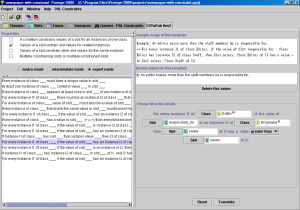Difference between revisions of "EZPal"
(added homepage url and screenshot) |
(incremental save of new work) |
||
| Line 12: | Line 12: | ||
|Affiliation1=Stanford Center for Biomedical Informatics Research | |Affiliation1=Stanford Center for Biomedical Informatics Research | ||
}} | }} | ||
| + | |||
| + | <div style="float:left; width:100%;"> | ||
| + | == Detailed Description == | ||
| + | EZPal is a tab widget plug-in for Protege that was designed to facilitate acquisition of Protege Axiom Language (PAL) based constraints without having to understand the language itself. Using a library of templates based on reusable patterns of previously encoded axioms, the interface allows users to compose constraints using a "fill-in-the-blanks" approach that parallels the object-attribute-value representation metaphor of Protege. | ||
| + | |||
| + | === Organizational Overview === | ||
| + | |||
| + | The tab makes use of a Protege ontology to store three major categories of information EZPal presents in the interface: | ||
| + | |||
| + | * '''Pattern:''' A pattern is defined as a logical sentence derived from a group of axioms that are structurally identical except for specific references. Individual patterns are not stored explicitly in the library but further generalized into templates. The form at the bottom right corner which allows value inputs for axiom-instantiation is a particular pattern representation of a template. | ||
| + | * '''Template:''' each template describes a set of frequently used axiom design patterns based on their semantic and structural similarities, or possibly one pattern only if it is unique. It stores the relevant 'variation' information to allow retrieval of a specific pattern to allow value entries for axiom generations. | ||
| + | * '''Property:''' A property is an abstract description for the common features of a group of templates. Properties are not mutually exclusive: each template may satisfy more than one property. | ||
| + | |||
| + | Currently, the library has 20 templates and 4 properties. | ||
| + | |||
| + | == Installation == | ||
| + | |||
| + | == Documentation == | ||
| + | EZPal documentation is hosted on the main Protege website: | ||
| + | |||
| + | View [http://protege.stanford.edu/plugins/ezpal/EZPal_Documentation.html documentation] | ||
| + | |||
| + | View [http://smi-web.stanford.edu/auslese/smi-web/research/details.jsp?PubId=933 reference paper] | ||
| + | |||
| + | == Level of Support == | ||
| + | This plug-in is no longer under active development. | ||
| + | <br /><br /> | ||
| + | </div> | ||
Revision as of 13:49, July 8, 2008
EZPal
by Johnson Hou
Facilitate acquisition of Protege Axiom Language (PAL) based constraints without having to understand the language itself.
Contents
Versions & Compatibility
This section lists available versions of EZPal.
No version information available.
If you click on the button below to add a new version of EZPal, you will be asked to define a page title for the new version. Please adhere to the naming convention of EZPal X.X.X when you define the new page!
Changelog
No version information available.
Detailed Description
EZPal is a tab widget plug-in for Protege that was designed to facilitate acquisition of Protege Axiom Language (PAL) based constraints without having to understand the language itself. Using a library of templates based on reusable patterns of previously encoded axioms, the interface allows users to compose constraints using a "fill-in-the-blanks" approach that parallels the object-attribute-value representation metaphor of Protege.
Organizational Overview
The tab makes use of a Protege ontology to store three major categories of information EZPal presents in the interface:
- Pattern: A pattern is defined as a logical sentence derived from a group of axioms that are structurally identical except for specific references. Individual patterns are not stored explicitly in the library but further generalized into templates. The form at the bottom right corner which allows value inputs for axiom-instantiation is a particular pattern representation of a template.
- Template: each template describes a set of frequently used axiom design patterns based on their semantic and structural similarities, or possibly one pattern only if it is unique. It stores the relevant 'variation' information to allow retrieval of a specific pattern to allow value entries for axiom generations.
- Property: A property is an abstract description for the common features of a group of templates. Properties are not mutually exclusive: each template may satisfy more than one property.
Currently, the library has 20 templates and 4 properties.
Installation
Documentation
EZPal documentation is hosted on the main Protege website:
View documentation
View reference paper
Level of Support
This plug-in is no longer under active development.
